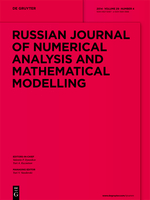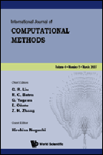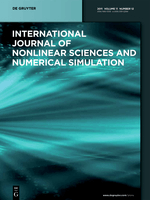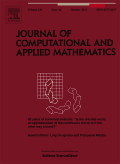
JOURNAL OF ENGINEERING MATHEMATICS
Scope & Guideline
Fostering interdisciplinary dialogue for a better tomorrow.
Introduction
Aims and Scopes
- Mathematical Modeling in Engineering:
The journal publishes papers that develop mathematical models to describe and analyze engineering phenomena, providing insights into complex systems such as fluid dynamics, thermodynamics, and structural mechanics. - Numerical Analysis and Computational Methods:
Research that focuses on numerical techniques and computational algorithms for solving mathematical problems in engineering contexts is a major focus. This includes finite element methods, boundary element methods, and other numerical simulation approaches. - Interdisciplinary Approaches:
The journal encourages interdisciplinary research that applies mathematical techniques to various engineering disciplines, including but not limited to mechanical, civil, and chemical engineering. - Stability and Control Analysis:
Papers addressing stability analysis, control theory, and optimization in engineering applications are frequently featured, reflecting the journal's commitment to advancing these critical areas of research. - Fluid Dynamics and Heat Transfer:
Research related to fluid dynamics, heat transfer, and their interactions with materials and structures is a core area, encompassing both theoretical and experimental studies.
Trending and Emerging
- Advanced Computational Techniques:
There is a growing interest in advanced computational methods, including machine learning and artificial intelligence applications in engineering mathematics, enhancing the ability to analyze and solve complex problems. - Multi-Phase Flow and Interfacial Phenomena:
Research focusing on multi-phase flow dynamics and interfacial phenomena, particularly in the context of energy applications and environmental engineering, is increasingly prevalent. - Nonlinear Dynamics and Stability Analysis:
Emerging themes include nonlinear dynamics, bifurcation analysis, and stability studies, especially in complex systems where traditional linear models may not suffice. - Bioengineering and Biomechanics Applications:
The journal is witnessing a rise in studies related to bioengineering and biomechanics, reflecting the interdisciplinary nature of modern engineering and the integration of mathematical modeling in biological systems. - Sustainable Engineering Practices:
Research that addresses sustainability, including mathematical modeling for environmental impact, renewable energy systems, and resource management, is gaining momentum as global challenges demand innovative solutions.
Declining or Waning
- Classical Analytical Solutions:
There has been a noticeable decrease in papers focusing solely on classical analytical methods for solving fundamental equations, as researchers increasingly favor numerical methods and computational approaches. - Static Structural Analysis:
The focus on static structural analysis without consideration of dynamic effects or real-world complexities has waned, as there is a growing emphasis on dynamic response and time-dependent behaviors in engineering applications. - Simplistic Models without Real-World Application:
The journal has seen fewer submissions of simplistic or overly theoretical models that do not directly address practical engineering challenges, as there is a stronger push towards papers that demonstrate applicability and relevance to current engineering problems. - Traditional Heat Transfer Studies:
Traditional studies on heat transfer in isolated systems have decreased, with more research focusing on complex interactions, multi-phase flows, and advanced materials. - Basic Fluid Mechanics without Application:
Research that presents basic fluid mechanics principles without a strong application to engineering problems is becoming less frequent, as the journal shifts towards more applied and interdisciplinary studies.
Similar Journals

RUSSIAN JOURNAL OF NUMERICAL ANALYSIS AND MATHEMATICAL MODELLING
Illuminating the Intersection of Theory and Application in MathematicsRUSSIAN JOURNAL OF NUMERICAL ANALYSIS AND MATHEMATICAL MODELLING, published by WALTER DE GRUYTER GMBH in Germany, is a vital resource for researchers and practitioners in the fields of numerical analysis, mathematical modeling, and computational mathematics. With an ISSN of 0927-6467 and an E-ISSN of 1569-3988, this journal has been disseminating significant findings since its inception in 1986 and continues to do so into 2024. Despite its current position in Q4 category quartiles and modest Scopus rankings, it provides a platform for innovative research that contributes to the evolution of modeling and simulation techniques. The journal is committed to fostering an understanding of complex numerical methods and their applications across various scientific disciplines. Although it does not provide Open Access options, it remains a key publication that underscores the importance of rigorous mathematical analysis and its practical implications in today's technology-driven world.

JAPAN JOURNAL OF INDUSTRIAL AND APPLIED MATHEMATICS
Advancing Innovation in Applied MathematicsThe Japan Journal of Industrial and Applied Mathematics, published by Springer Japan KK, is a pivotal platform for disseminating cutting-edge research in the fields of applied mathematics and engineering. With an ISSN of 0916-7005 and an E-ISSN of 1868-937X, this journal has been a cornerstone in the academic community since its inception in 1991 and will continue to contribute pivotal insights through 2024. Positioned in the Q3 category for both Applied Mathematics and Miscellaneous Engineering according to 2023 rankings, it is recognized for its diverse range of topics and interdisciplinary approaches. Despite its competitive ranking, the journal fosters valuable contributions that challenge conventional methodologies and inspire innovation. Researchers, professionals, and students alike will find the journal’s contents invaluable for advancing knowledge and exploring new methodologies in industrial and applied mathematics.

COMPUTATIONAL MATHEMATICS AND MATHEMATICAL PHYSICS
Pioneering Numerical Analysis and Applied MathematicsCOMPUTATIONAL MATHEMATICS AND MATHEMATICAL PHYSICS is a prestigious journal published by PLEIADES PUBLISHING INC, dedicated to advancing the fields of computational mathematics and mathematical physics. With an ISSN of 0965-5425 and an E-ISSN of 1555-6662, the journal has established its importance within the academic community since its inception in 1985. It is classified in the third quartile (Q3) for computational mathematics in 2023, and while currently it does not offer open access options, it remains a valuable resource for researchers seeking to disseminate their findings and engage with cutting-edge developments in the field. The journal encompasses a broad spectrum of topics, including numerical analysis, applied mathematics, and the intersection of physics and computational techniques, highlighting its relevance in addressing complex problems in both theoretical and applied contexts. Scholars will find a platform that not only promotes rigorous research but also encourages collaboration and innovation within the scientific community.

International Journal of Computational Methods
Unveiling cutting-edge techniques to transform computational challenges.The International Journal of Computational Methods is a premier academic journal dedicated to advancing the field of computational mathematics and its applications in various domains of computer science. Published by WORLD SCIENTIFIC PUBL CO PTE LTD, this journal serves as a critical platform for researchers and practitioners to disseminate innovative computational techniques and methodologies that address complex problems in science and engineering. With a significant focus on fostering interdisciplinary collaboration, the journal is essential for those looking to explore cutting-edge topics in computational methods. Established in 2006 and spanning until 2024, it holds respectable rankings in Q3 for Computational Mathematics and Q2 for Miscellaneous Computer Science as of 2023, reflecting its growing impact in the academic community. Although the journal is not currently open access, it offers various subscription options to enable access to its high-quality research articles. By bridging theoretical advancements and practical implementations, the International Journal of Computational Methods plays a vital role in shaping future innovations within both academic and industrial settings.

INTERNATIONAL JOURNAL OF NONLINEAR SCIENCES AND NUMERICAL SIMULATION
Pioneering Research in Nonlinear PhenomenaINTERNATIONAL JOURNAL OF NONLINEAR SCIENCES AND NUMERICAL SIMULATION, published by WALTER DE GRUYTER GMBH, serves as a premier platform for advancing knowledge in the vibrant domains of applied mathematics, computational mechanics, and various fields of engineering and physics. With an ISSN of 1565-1339, this journal has been at the forefront of disseminating significant research findings since its inception in 2000. Its commitment to quality is reflected in its category quartiles for 2023, ranked Q2 in Computational Mechanics and Engineering (miscellaneous), and Q3 in multiple engineering disciplines. Although it currently operates under a subscription model, the journal remains dedicated to presenting groundbreaking studies that explore complex nonlinear phenomena and numerical methodologies. As an invaluable resource for researchers, professionals, and students alike, the journal aims to foster innovation and collaboration across related fields, enhancing both theory and application through its peer-reviewed articles.

JOURNAL OF COMPUTATIONAL AND APPLIED MATHEMATICS
Advancing the Frontiers of Applied MathematicsJOURNAL OF COMPUTATIONAL AND APPLIED MATHEMATICS, published by Elsevier, stands as a premier platform for researchers and practitioners in the fields of applied and computational mathematics. With an impressive convergence history from 1975 to 2025, this journal has established itself as a crucial reference point for innovative mathematical theories, methodologies, and applications. Holding a distinguished position in Scopus rankings—#85 out of 635 in Applied Mathematics and #36 out of 189 in Computational Mathematics—it operates in the highly competitive Q2 quartile for both disciplines as of 2023. Although currently not designated as an open-access journal, it remains widely respected for its rigorous peer-review process and high-quality research contributions. Researchers and professionals seeking to advance their work and engage with cutting-edge developments will find this journal an invaluable resource, fostering a deeper understanding and collaboration within the mathematical community.

MECCANICA
Connecting Ideas in Condensed Matter and MechanicsMECCANICA, an esteemed journal published by Springer, stands at the forefront of research in the fields of Condensed Matter Physics, Mechanical Engineering, and Mechanics of Materials. Established in 1966 and continuing through 2024, this journal provides a robust platform for the dissemination of innovative research and advancements in these increasingly interconnected domains. With an impressive 2023 ranking placing it in the Q2 category across multiple fields, MECCANICA boasts a Scopus rank of #198 in Mechanical Engineering, #150 in Condensed Matter Physics, and #141 in Mechanics of Materials, highlighting its significance and influence within the scholarly community. The journal aims to foster dialogue among researchers, professionals, and students, facilitating the exchange of cutting-edge ideas and methodologies crucial for overcoming contemporary engineering and physics challenges. Readers can access a wealth of knowledge through its comprehensive articles, and while it does not currently offer open access, the journal remains instrumental in shaping the future of engineering and physical sciences.

COMPUTATIONAL MECHANICS
Exploring the Synergy of Mathematics and MechanicsCOMPUTATIONAL MECHANICS, published by SPRINGER, is a premier international journal that focuses on the intersection of applied mathematics, engineering, and computational methods. With a commendable Q1 ranking in multiple categories, including Applied Mathematics and Mechanical Engineering, this journal is pivotal for disseminating groundbreaking research and innovative methodologies that advance the field. The journal has steadily contributed to the academic community since its inception in 1986 and continues to lead discussions and practices in computational mechanics and related disciplines. With a robust impact reflected in its Scopus rankings—placing it within the top percentiles across various categories—COMPUTATIONAL MECHANICS serves as a crucial platform for researchers, professionals, and students seeking to explore and contribute to significant advancements in computational theory and mathematical applications. Although it does not currently operate under an open access model, the journal ensures wide accessibility through libraries and institutional subscriptions, fostering a rich exchange of knowledge in the global scientific community.

Advances in Applied Mathematics and Mechanics
Driving Innovation through Interdisciplinary ResearchAdvances in Applied Mathematics and Mechanics is a premier academic journal published by GLOBAL SCIENCE PRESS that focuses on the latest research and innovative developments in the fields of applied mathematics and mechanical engineering. Since its inception in 2009, this journal has consistently contributed to the advancement of knowledge, garnering a respectable Q2 ranking in both Applied Mathematics and Mechanical Engineering categories, reflecting its significance in enhancing scientific discourse. With an impactful reach, as evidenced by its Scopus rankings, this journal hosts cutting-edge research, theoretical advancements, and practical applications that serve as invaluable resources for researchers, professionals, and students alike. While it operates under a subscription model, the accessibility of vital research findings is critical for driving innovation within these interrelated disciplines. The journal’s scope encompasses a broad range of topics, from computational methods to engineering applications, positioning it as a crucial platform for interdisciplinary collaboration and knowledge sharing in an ever-evolving academic landscape. For prospective authors and readers, Advances in Applied Mathematics and Mechanics stands as a key contributor to confidently navigating the nexus of applied mathematics and mechanics.

Results in Applied Mathematics
Exploring New Frontiers in Applied MathematicsResults in Applied Mathematics, published by Elsevier, stands as a vital resource in the field of applied mathematics, demonstrating strong academic rigor with an impressive Q2 ranking in its category for 2023. With an ISSN of 2590-0374 and an E-ISSN of 2590-0374, this open-access journal, established in 2019, provides an innovative platform for researchers, professionals, and students to disseminate and access cutting-edge research findings. The journal is indexed in Scopus, ranking #210 out of 635 in the applied mathematics category, placing it in the top 67th percentile of its field. With an aim to bridge theory and practice, Results in Applied Mathematics covers a diverse range of topics, fostering collaborations and providing insights that are integral to the advancement of mathematical applications across various disciplines.